

Patrician Palaces in Walk I
The following patrician palaces are in Walk I.
Palazzo Ancaiani (17th century)


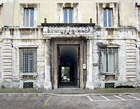
The palace was confiscated in the Napoleonic period and became the seat of the Prefettura del Trasimeno. The family subsequently regained possession of the palace but sold it to the Camera Apostolica in 1820, at which point it became the seat of the papal governors. It passed to the Provincial Authority in 1860 and to the Commune in 1927. It was restored in the 1960s after decades of neglect. It now houses the prestigious Centro Italiano di Studi sull' Alto Medioevo.
Cappella di San Benedetto (ca. 1680)
Decio Ancaiani built this family chapel to the left of the present palace, taking over the dedication of the local parish church that had been demolished [when ??]. The chapel, which was an impressive structure, was decorated in part by marble excavated from what turned out to be the site of the nearby Roman theatre.
Decio Ancaiani installed the altarpiece (1508) of the Adoration of the Magi by Giovanni di Pietro, lo Spagna on the high altar in 1733. (Eusebio Ancaiani had commissioned it originally for the high altar of the Abbazia di San Pietro in Valle, which the family held in commendam). The family took the altarpiece to Rome in 1825 and sold it to the art gallery of Berlin in 1833. It is now in the Staatliche Museen, Berlin.
Palazzo Campello (1597-1600)
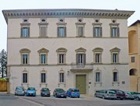
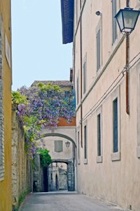
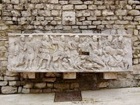
In 1831, Pompeo Campello, the president of the short-lived revolutionary council of Spoleto, hosted Louis Napoleon (the future Emperor Napoleon III of France) in the palace. The interior was remodelled in 1818.
For many years, Gian Carlo Menotti the founder of the Festival dei Due Mondi, rented the palace each summer as a headquarters for the event. An inscription on the facade commemorates Thomas Schippers (died 1977), who was for many years the director of the festival orchestra. The palace has recently been restored.
Palazzo Leti Sansi (17th century)
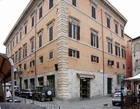
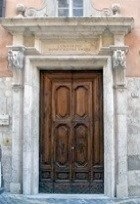
The palace subsequently passed to the Consorzio della Bonificazione Umbra (the water authority for the region).
Palazzo Mauri (ca. 1600)
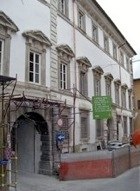
The palace passed to the Commune in 1918 and now houses the Accademia Spoletina (founded in the 17th century), the Biblioteca Comunale and the Archivio di Stato (in the adjoining Palazzetto Sillani).
During excavation in 2004-8, prior to the recent restoration, the remains of a Roman mosaic and of Roman baths were discovered.
Palazzo Pianciani (18th century)
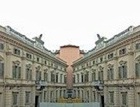
The palace now houses Banca Popolare di Spoleto.
During excavation in 2006-7, prior to the recent restoration, the remains of a Roman house and baths, a Lombard baptistery and medieval streets were discovered here.
Palazzo Ràcani Arroni (early 16th century)
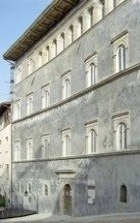
The facade is decorated with monochrome frescoes (16th century) of mythological subjects. These seem to be by an artist who was influenced by the work of the followers of Raphael in Rome in the 1520s, and who probably also painted the frescoes (ca. 1535) of the vault of the Cappella dell' Assunta in the Duomo. He has been identified alternatively as:
-
✴Giovanni da Spoleto, who is known only from his signature (along with that of Vincenzo Tamagni) on the frescoes (1516) in the apse of Santa Maria di Arrone; or
The portal at the centre of the facade of the palace leads to an inner courtyard that contains an interesting fountain, which has figures of Artemis and two other pagan divinities.
Palazzo Rosari Spada (ca. 1700)
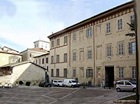
The palace housed the Accademia degli Ottusi in the 17th century. It passed by inheritance from the Rosari to the Spada family in 1664. The Marignoli family acquired it early in the 19th century.
There are the remains of a Roman wall in the courtyard.
Patrician Palaces in Walks II and III
Palazzo Benedetti di Montevecchio (16th century)
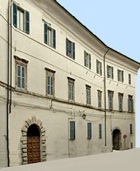
The main facade is in Via Gregorio Elladio. The rear facade stands on the ancient city walls and has a fine loggia overlooking the valley below.
Frescoes (ca. 1780)
The frescoes on the ceiling of a small room on the piano nobile, which are signed by Liborio Coccetti, include depictions of:
-
✴the Assumption of the Virgin, in the chapel; and
-
✴allegories of music, in the boudoir.
(They are illustrated in the site of Fondazione Federico Zeri).
Palazzo Collicola (1717-30)
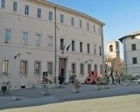
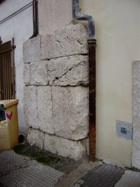
The palace was richly furnished: its tapestries were bought from the estate of Queen Christina of Sweden. [A painting from the palace of the Virgin in Purgatory by Pietro Machuca is now in the Prado, Madrid.]
The palace has hosted a number of important visitors, including:
-
✴ the future King Charles III of Spain in 1734;
-
✴Pope Pius VI, who stayed here in 1782 on his way to Vienna; and
-
✴King Charles Emanuel IV of Sardinia, who stayed here in 1801 as he fled the advance of Napoleon's troops.
It was also expropriated for use, in turn, by the officers of the Spanish, Italian and French armies.
The family became extinct in 1939 and the palace passed to the Commune. It now houses the Galleria Civica d’ Arte Moderna. It also houses a library of some 15,000 books that Giovanni Caradente gave to the city.
Palazzo Pucci della Genga (late 18th century)
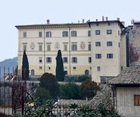
The palace passed to the della Genga family in the 19th century. Annibale della Genga, who became Pope Leo XII (1823-9) lived here. The family took the name Pucci della Genga after the marriage of Rodolfo Pucci Boncambi and Maria della Genga in the later part of the 19th century.
Palazzo Vigili (15th/16th centuries) and Torre dell’ Olio (13th century)
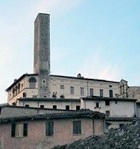
-
✴The main part of the palace in Via Porta Fuga (to the right in the illustration) dates to the 16th century.
-
✴The wing beyond the tower dates to the 15th century.
The palace takes its name from the Vigili family, which included Bishop Fabio Vigili (dates ??).
Return to Monuments of Spoleto.
Return to: Walk I;
Walk II (Palazzo Benedetti di Montevecchio; Palazzo Campello and
Palazzo Collicola); or
Walk III (Palazzo Pucci della Genga and Palazzo Vigili).

